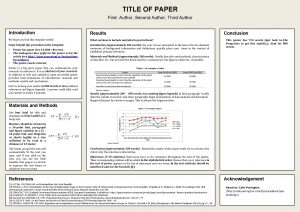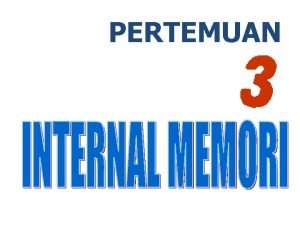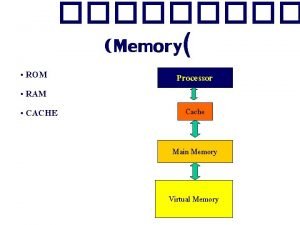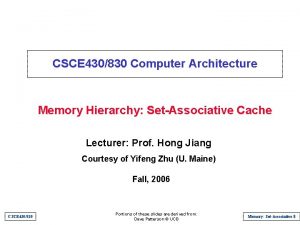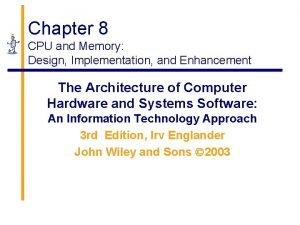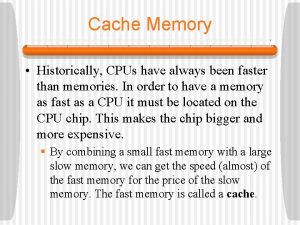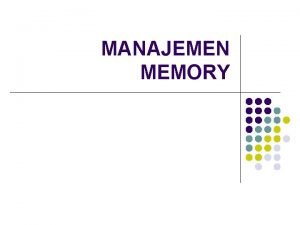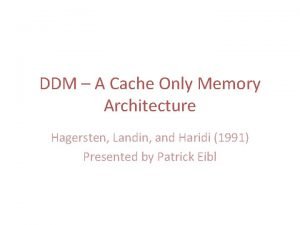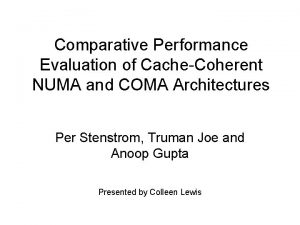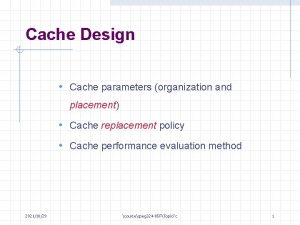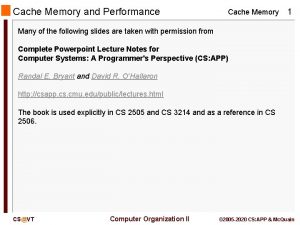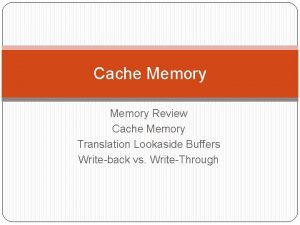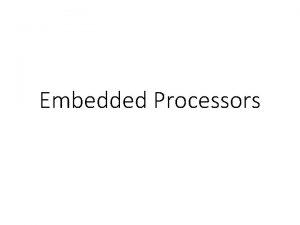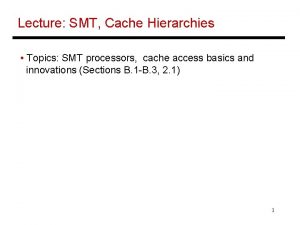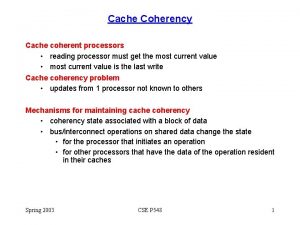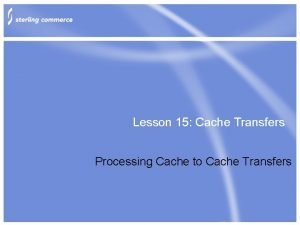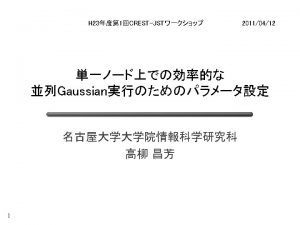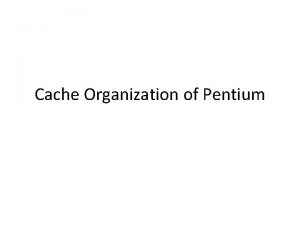Cache Memory Design for Network Processors Author TziCker



















- Slides: 19

Cache Memory Design for Network Processors Author : Tzi-Cker Chiueh, Prashant Pradhan Publisher : High-Performance Computer Architecture, 2000. Presenter : Jo-Ning Yu Date : 2010/11/03

2 Outline Introduction Baseline : Host Address Cache(HAC) Host Address Range Cache(HARC) Intelligent Host Address Range Cache(IHARC)

3 Introduction Rather than blindly pushing the performance of packet processing hardware, an alternative approach is to avoid repeated computation by applying the time-tested architectural idea of caching to network packet processing. Given caches of a fixed configuration, the only way to improve the cache performance is to increase their effective coverage of the IP address space, i. e. , each cache entry covering a larger portion of the IP address space.

4 Host Address Cache(HAC) Architecture

Host Address Cache(HAC) 5 A distinct difference between network packet streams and program reference streams is that the former lacks spatial locality, as evidenced by the fact that for a given cache size and degree of associativity, decreasing the block size monotonically decreases the cache miss ratio. Poorer performance for caches with larger block size results because larger block size leads to inefficient cache space utilization when references to addresses within the same block are not correlated temporally. We conclude that the block size of network processor caches should always be small, preferably one entry wide.

6 Host Address Cache(HAC) ※Assume the cache is directmapped and its block size is one entry wide. Unlike CPU cache, temporal inconsistency in the host address cache is tolerable, because the routing protocol itself takes time to converge to the new routes. Therefore, there is much more latitude in the timing of consistency maintenance actions. As the flush interval increases, the miss ratio decreases as expected. But the performance difference due to flushing, as shown by the ratio of the miss rates corresponding to the 100 K and ∞ flush intervals, increases with the cache size. The reason for this behavior is that larger caches require a longer cold-start time, and therefore tend to suffer more than smaller caches when the flush interval is small.

7 Host Address Range Cache(HARC) Each routing table entry corresponds to a contiguous range of the IP address space. For example, a routing table entry with a network address field of 0 x 82 f 50000 and a network mask field of 0 xffff 0000 corresponds to a contiguous range <0 x 82 f 50000 … 0 x 82 f 5 ffff> in the <0… 232 -1> IP address space. Network addresses need to go through two additional processing steps before host address range cache (HARC) could be put to practical use.

8 Host Address Range Cache(HARC) First, with the longest prefix match requirement, it is possible that some routing table entry’s address range covers another’s address range. The former is called an encompassing entry while the latter is an encompassed entry. An encompassing entry’s network address is a prefix of those entries it encompasses. The address range associated with each encompassed routing table entry needs to be ”culled” away from the address ranges of all the entries that encompass it, so that every address range in the IP address space is covered by exactly one routing table entry

9 Host Address Range Cache(HARC) Second, adjacent address ranges that share the same output interface should be merged into larger ranges as much as possible. Then the minimum of all resulting address range sizes is calculated. This minimum size becomes the minimum_range_granularity parameter of the HARC. Range size, which is defined as log(minimum_range_granularity), thus represents the number of least significant bits of an IP address that could be ignored during routing-table lookup, since destination addresses falling within a minimum address range size are guaranteed to have the same lookup result.

10 Host Address Range Cache(HARC) Architecture The destination address of an incoming packet is logically right -shifted by range size before being fed to the baseline cache. Because each address range corresponds to a cacheable entity, HARC’s effective coverage of the IP address space is increased by a factor of minimum range granularity.

11 Host Address Range Cache(HARC) ※Assume the block size is one entry wide. HAC’s miss ratio is between 1. 68 to 2. 11 times higher than that of HARC. In terms of average routing-table lookup time, HARC is between 58% and 78% faster than HAC, assuming that the hit access time is one cycle and the miss penalty is 120 cycles. The miss ratio gap between HAC and HARC widens with the degree of associativity, because HARC benefits more from higher degrees of associativity by eliminating more conflict misses than HAC.

Intelligent Host Address Range Cache(IHARC) A traditional CPU cache of size 2 K and block size 1 directly takes the least significant K bits of a given address to index into the data and tag arrays. In this section, we show that by choosing a more appropriate hash function for cache lookup, it is possible to further increase every cache entry’s coverage of the IP address space. 12

Intelligent Host Address Range Cache(IHARC) 13 ex : index bit為bit 1(ignore) 0000 -> 0001 -> 001 output interface 0100 -> 010 皆為 1 0101 -> 011 四個host address相鄰且output interface相同,可合併 In this case, the total number of address ranges is 8, because the minimum range granularity is 2. To further grow the address range that a cache entry can cover, one could choose the index bits carefully such that when the index bits are ignored, some of the identically labeled address ranges are now ”adjacent” and thus could be combined.

Intelligent Host Address Range Cache(IHARC) 14 The K index bits divide the IP address space into 2 K partitions, each of which is mapped to one cache set. Each partition contains a number of address ranges and each range is associated with an output interface that is different from its neighboring address ranges.

Intelligent Host Address Range Cache(IHARC) 16 Architecture Since distinct address ranges in a cache set need unique tags, the number of distinct address ranges in a cache set represents the degree of contention in the cache set. Thus, the index bits are selected in such a way that after the merging operation, the total number of address ranges and the difference between the number of address ranges across cache sets is minimized.

Intelligent Host Address Range Cache(IHARC) 17

Intelligent Host Address Range Cache(IHARC) 18 Mi(S) is the number of ranges in the ith partition resulting from the set of index bits S. M(S) is the average of the metric Mi(S) over all partitions i. The first term of Equation 1 represents the total number of cacheable entities competing for the entire cache. The second term is called the deviation term. It quantifies the deviation in the number of cacheable entities across all the partitions induced by the set of index bits S. In other words, the first and second terms measure the extents of capacity and conflict misses respectively. The weighting factor w in Equation 1 determines the relative importance of conflict miss reduction with respect to capacity miss reduction.

Intelligent Host Address Range Cache(IHARC) 19 However, a general range check is still too expensive to be incorporated into caching hardware. By guaranteeing that each address range size is a power of two and that the starting address of each range is aligned with a multiple of its size during the merge step, one can perform the range check simply by a mask-and-compare operation. Therefore, each tag memory entry in the IHARC includes a tag field as well as a mask field, which specifies the bits in the address to be used in the ’tag match’. To put these numbers in perspective, the number of entries in the original routing table is 39, 681, and the number of address ranges from HARC is 227 or 134, 217, 728.

Intelligent Host Address Range Cache(IHARC) 20 Compared to HAC, HAC IHARC reduces the average routing table lookup time by up to a factor of 5. In terms of average routing-table lookup time, HARC is between 2. 24 and 3. 18 times slower than IHARC. This is because HARC’s HARC miss ratios are 2. 91 to 7. 09 times larger than IHARC’s. In addition, the miss ratio gap between HARC and IHARC increases with the degree of associativity. ※Assume the block size is one entry This result conclusively demonstrates that wide. there is significant performance improvement to be gained from IHARC over HARC.
 Network systems design using network processors
Network systems design using network processors Page fault
Page fault First author second author third author
First author second author third author Cache memory design
Cache memory design Termasuk operasi pembacaan cache memory
Termasuk operasi pembacaan cache memory Karakteristik cache memory
Karakteristik cache memory Set associative mapping in cache memory
Set associative mapping in cache memory Ramcache
Ramcache Direct mapping cache
Direct mapping cache Cache vs memory
Cache vs memory Computer memory system overview
Computer memory system overview Cache vs memory
Cache vs memory Cache memory is faster than
Cache memory is faster than Cache memory adalah
Cache memory adalah Cache operation
Cache operation Cache memory organization
Cache memory organization Makalah manajemen memori
Makalah manajemen memori Cache memory is invisible to the os
Cache memory is invisible to the os Cache only memory architecture
Cache only memory architecture Cache only memory architecture
Cache only memory architecture


